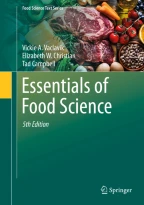
Food quality is an important concept because the food people choose depends largely on quality. Consumer preference is important to the food manufacturer, who wants to gain as wide a share of the market for the product as possible. Quality is difficult to define precisely, though it refers to the degree of excellence of a food and includes all the characteristics of a food which are significant and make the food acceptable.
This is a preview of subscription content, log in via an institution to check access.
eBook EUR 53.49 Price includes VAT (France)
Softcover Book EUR 68.56 Price includes VAT (France)
Tax calculation will be finalised at checkout
Purchases are for personal use only
Used to determine whether a specific consumer group likes or prefers a particular product.
Sheet of paper on which the panelist receives pertinent sample information and instructions, and on which observations are recorded during a sensory test.
Descriptive tests:
Specialized difference tests used to describe specific flavor attributes of a product, or to describe degree of difference between products.
Discrimination or difference tests:
Used to determine if there is a perceivable difference between samples.
Duo–trio test:
Samples include a reference food and two samples, one of which is the same as the reference.
Ability of a material to stretch when a force is applied and to return to its original position when the force is removed.
Likeability test:
Panelists rate a sample on a hedonic scale from “dislike extremely” to “like extremely.”
Master sheet:
Details the specific three-digit product numbers and positions for every panelist in a sensory test. Used to ensure that each product is seen an equal number of times in each position so that bias is avoided.
Textural qualities of a food as perceived in the mouth.
Newtonian liquid:
The viscosity is independent of the shear rate. Stirring or shaking does not make the liquid runnier or thicker. Examples are water, sugar syrups, and wine.
Non-Newtonian liquid/fluid:
Apparent viscosity depends on the shear rate. Catsup gets thinner with increasing shear rate, whereas some gums thicken with increasing shear rate.
Objective evaluation:
Involves use of physical and chemical techniques to evaluate food quality, instead of variable human sensory organs.
Material flows when subjected to a certain minimum force; material can be molded.
p Value:
Statistical probability that a result is significant. A p value of 0.01 indicates 99% confidence that a result is significant. In other words, out of 100 trials, the same result would be expected 99 times. The probability of the opposite result occurring is only 1 in 100 trials.
Ranking test:
Panelists rank two or more samples in order of preference or intensity for a particular attribute.
Science of the deformation and flow of matter, how a food reacts when force is applied; it includes elasticity, viscosity, and plasticity.
Sensory testing:
Use of senses to evaluate products; it involves consumer opinion.
Concentration required for identification of a particular substance.
Triangle test:
Three samples, two of which are alike, one is odd.
Savory taste, given by substances such as monosodium glutamate.
Resistance to flow of a liquid when a shear force is applied. Liquids with a low viscosity flow readily, whereas liquids with a high viscosity flow slowly.
© 2021 The Editor(s) (if applicable) and The Author(s), under exclusive license to Springer Nature Switzerland AG
Vaclavik, V.A., Christian, E.W., Campbell, T. (2021). Evaluation of Food Quality. In: Essentials of Food Science. Food Science Text Series. Springer, Cham. https://doi.org/10.1007/978-3-030-46814-9_1
Anyone you share the following link with will be able to read this content:
Get shareable link
Sorry, a shareable link is not currently available for this article.
Copy to clipboard
Provided by the Springer Nature SharedIt content-sharing initiative